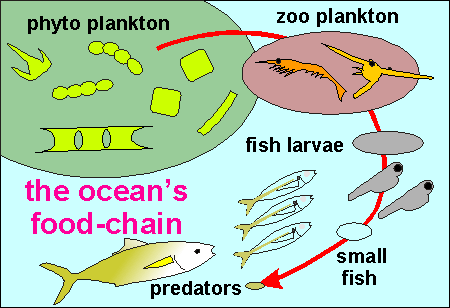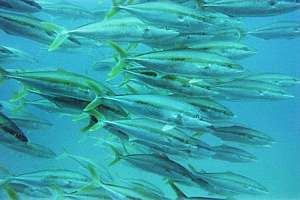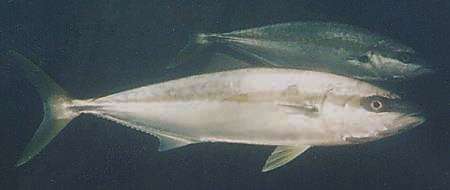|
by Dr Floor Anthoni www.seafriends.org.nz/indepth/kingfish.htm |
 |
 |
|
by Dr Floor Anthoni www.seafriends.org.nz/indepth/kingfish.htm |
 |
 |
When fish don’t bite, it could mean that their numbers are down through over-fishing, but it could also mean something else. People who visit the sea frequently or who work with it, often have interesting observations to report. How could their observations help us to better understand our environment? In recent times we have observed massive fish mortalities that were difficult to explain until the cause of a mysterious sickness in the sea was discovered by Dr Anthoni. Study the related chapters for a deeper understanding. |
Whenever a fisherman, amateur or professional, goes fishing, he or she takes a sample (the catch) from the sea. Sometimes the fishing is good, sometimes bad. The vagaries of nature cause our sample to vary randomly. As the fish stock gradually becomes over-fished, we need to work harder, in order to catch the same amount and the fish we catch becomes smaller. Fisheries managers who oversee our fish stocks with the help of computer models, call it ‘catch per unit effort’ and they adjust their modelled fish stocks accordingly. So when kingfish is harder to catch, it is only fair to assume that they have diminished.
As a diver, my ‘sample’ is what my eyes and my camera see. It is no better than the fisherman’s but different. I have on several occasions seen that fish are plentiful around but none are being caught. I see fishermen trawl repeatedly through dense schools of trevally (related to kingfish) but the fish is not at all interested in the fisherman’s bait. Maybe it has to do with how well the fish is fed and how much of their traditional food is available. Unfortunately for the kingfish, a top level predator, food is sometimes scarce.
 The accompanying diagram shows one of the ocean’s food-chains, of which
the kingfish is king.
For it to grow one kilogram, it needs to catch and eat some 10kg of small
fish (pilchard, koheru, jack mackerel). These in turn have to gobble some
10kg of fish larvae or pelagic shrimps, which have to eat large amounts
of plant plankton. So, for a predator to thrive, large amounts of biomass
need to be available down the food chain. For a kingfish perhaps as much
as 500kg phyto plankton for it to grow by only one kg!
The accompanying diagram shows one of the ocean’s food-chains, of which
the kingfish is king.
For it to grow one kilogram, it needs to catch and eat some 10kg of small
fish (pilchard, koheru, jack mackerel). These in turn have to gobble some
10kg of fish larvae or pelagic shrimps, which have to eat large amounts
of plant plankton. So, for a predator to thrive, large amounts of biomass
need to be available down the food chain. For a kingfish perhaps as much
as 500kg phyto plankton for it to grow by only one kg!
Naturally, this food is not available all the time, so kingfish (and its smaller prey-fish even more so) must cope with feast and famine. In the spring, the plant-plankton (phytoplankton) blooms enthusiastically because of warmer water, brighter sunlight and fertility provided by the winter rains. By March, the feast is over but another, smaller feast sometimes awaits in autumn. According to this logic, kingfish and others should bite most greedily from March to April and July to September. But if their food disappears altogether, the kingfish should eventually follow.
In 1992/93/94, and again in 2002/03, a major disaster happened to the
coastal seas of northeast New Zealand. Fish of many species disappeared
altogether, or their numbers diminished substantially. Read the aarticle
The
disappearing fish act, as it was published in the Divelog magazine.
Most plankton-feeding species were affected: blue maomao, trevally, koheru,
demoiselles and kingfish. This mass-mortality can be explained from the
phytoplankton becoming poisonous, which can happen occasionally when densities
exceed a given limit, because of overfertilisation. Several of the smallest
planktonic organisms, mainly dinoflagellates, are very poisonous, and they
may become numerous for reasons not understood. Shrimps feeding on the
phytoplankton, can become poisoned, but if they are eaten, the poison travels
up the food chain to small fish and eventually to kingfish and seabirds,
and also dolphins. Such poisons are often accumulated (like DDT), resulting
in mass mortalities of creatures of all kind.
The creatures of the plankton most sensitive to such disasters, are
the young fish, the larvae and young recruits. It results in recruitment
failure. Such failure to produce offspring is not noticed immediately,
but only after a number of years when the old fish have been fished down.
It thus seems as if suddenly the old fish disappeared.
Is kingfish poisoned, less hungry, over-exploited or has their food disappeared? Will we ever know? Nature is often complicated and fascinating. Ironically, every fisherman could help to unravel its mysteries simply by maintaining a good catch log (date, exact location, hours fished and amount of bait used (effort), number of rods used, quantities and species, with weights or body lengths). By recording their catches faithfully, they could contribute to the knowledge of our oceans - it’s called monitoring. The new millennium will bring changes beyond our wildest imagination, and they will certainly not all be for the better. To keep track of how our environment is changing, is necessary in order to be able to navigate the waters of the future.
Here at Seafriends, we are interested in piecing this puzzle together,
to record your observations. Perhaps you may also wish to help.
 Kingfish
(Seriola
grandis) are perhaps the most impressive fish around NZ. They can grow
as big as our small dolphins. They are beautifully efficient, even awesome.
They hunt in small groups. They swim very fast. They fight savagely when
caught and their flesh which has few bones, tastes good. They roam vast
distances and are hard to protect inside marine reserves. Kingfish
(Seriola
grandis) are perhaps the most impressive fish around NZ. They can grow
as big as our small dolphins. They are beautifully efficient, even awesome.
They hunt in small groups. They swim very fast. They fight savagely when
caught and their flesh which has few bones, tastes good. They roam vast
distances and are hard to protect inside marine reserves.
Their round bodies are extremely well streamlined which allows them to cruise effortlessly at high speed. With a few flicks of their tails they can accelerate quickly to a high speed. But their round, streamlined bodies do not allow them to dodge quickly. When attacking school fish such as young koheru, jack mackerel and pilchard, they work co-operatively as a group, creating confusion in the attacked school and making quick passes in and out of the scattering school. Meeting a big one of nearly 2m and 50kg is a breathtaking experience. Also being buzzed by some twenty smaller ones of 1.2m is quite awesome, even frightening. Kingfish can grow quite old but nobody knows how old they can get. Notice how each fish has markings differing from all others. By these markings (their 'names') they can distinguish each other. |
 This
picture shows two kingfish of a group of over ten, exhibiting signs of
starvation. Their bodies are no longer round and fat but sideways compressed,
while a depression shows just in front of the anal fin. It is normal for
mature fish to show hollow bellies after spawning but these fish have lost
their fatty layer, a sign of starvation. This photo was taken on 4 May
1999 at McGregor's Rock, north-east of Mangawhai. Unfortunately this photo
was the best out of three bad photos, but all showing emaciated bodies. This
picture shows two kingfish of a group of over ten, exhibiting signs of
starvation. Their bodies are no longer round and fat but sideways compressed,
while a depression shows just in front of the anal fin. It is normal for
mature fish to show hollow bellies after spawning but these fish have lost
their fatty layer, a sign of starvation. This photo was taken on 4 May
1999 at McGregor's Rock, north-east of Mangawhai. Unfortunately this photo
was the best out of three bad photos, but all showing emaciated bodies. |
-- Seafriends home -- indepth
index -- site map -- Revised: 20010530,20030317,20030328,